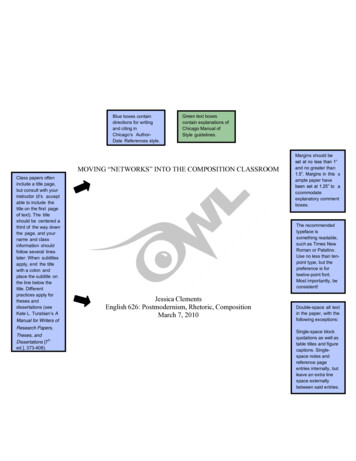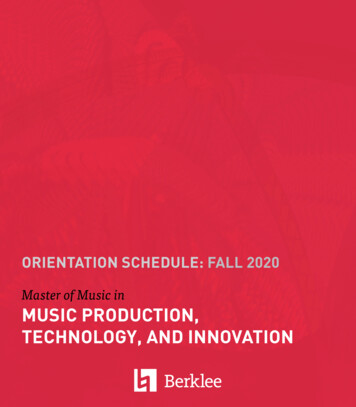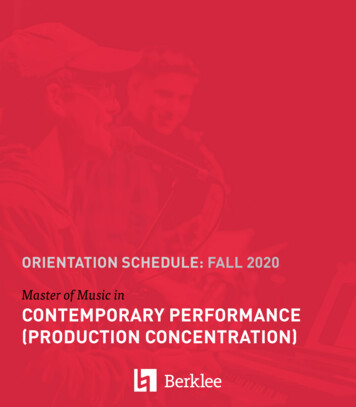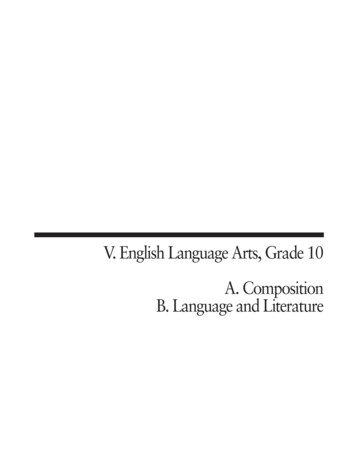
Transcription
Blue boxes containdirections for writingand citing inChicago’s AuthorDate References style.Green text boxescontain explanations ofChicago Manual ofStyle guidelines.Margins should beMOVING “NETWORKS” INTO THE COMPOSITION CLASSROOMClass papers ofteninclude a title page,but consult with youracceptable to include thetitle on the first pageof text). The titleshould be centered athird of the way downthe page, and yourname and classinformation shouldfollow several lineslater. When subtitlesapply, end the titlewith a colon andplace the subtitle onthe line below thetitle. Differentpractices apply fortheses anddissertations (seeKate L. Turabian’s AManual for Writers ofResearch Papers,Theses, andthDissertations [7ed.], 373-408).and no greater thansample paper haveaccommodateexplanatory commentboxes.The recommendedtypeface issomething readable,such as Times NewRoman or Palatino.Use no less than tenpoint type, but thepreference is fortwelve-point font.Most importantly, beconsistent!Jessica ClementsEnglish 626: Postmodernism, Rhetoric, CompositionMarch 7, 2010Double-space all textin the paper, with thefollowing exceptions:Single-space blockquotations as well astable titles and figurecaptions. Singlespace notes andreference pageentries internally, butleave an extra linespace externallybetween said entries.
Arabic page numbersbegin in the header ofthe first page of text.1In Democracy and Other Neoliberal Fantasies, Jodi Dean (2009) argues thatChicago’sAuthor-DateReferencesstyle isrecommendedfor those in thephysical,natural, andsocial sciencesand requiresusingparentheticalcitation toidentify sourcesas they showup in the text.Each sourcethat shows up“imagining a rhizome might be nice, but rhizomes don’t describe the underlying structureof real networks” (30), rejecting the idea that there is such a thing as a nonhierarchicalinterconnectedness that structures our contemporary world and means of communication.Michael Hardt and Antonio Negri (2009), on the other hand, argue that the Internet is anexemplar of the rhizome: a nonhierarchical, noncentered network—a democratic networkwith “an indeterminate and potentially unlimited number of interconnected nodes [that] communicate with no central point of control” (299). What is at stake in settling this dispute?in the text musthave aBeing. And, knowledge and power in that being. More specifically, this paper explorescorrespondingentry in thehow a theory of social ontology has evolved to theories of social ontologies,References list.how the modernist notion of global understanding of individuals working toward acommon (rationalized and objectively knowable) goal became pluralistic postmodernParentheticalcitationcomprises theauthor’s lastname, thepublicationdate, and thepage number ofthe source( whenapplicable).Keep in mindthat when asource is listedon thereferencespage by editoror translatorinstead ofauthor, you donot includeabbreviationssuch as ed. ortrans. in the intext citation.theories embracing the idea of local networks. Furthermore, what this summary journeyof theoretical evolution allows for is a consideration of why understandings of a worldcomprising emergent networks need be of concern to composition instructors and theirpractical activities in the classroom: networks produce knowledge.Our journey begins with early modernism, and if early modernism had a theme, itwas oneness. This focus on oneness or unity, on the whole rather than on individual parts,derived from Enlightenment thinking: “The project [of modernity] amounted to anextraordinary intellectual effort on the part of Enlightenment thinkers to develop objectivescience, universal morality and law, and autonomous art according to their innerlogic.” Science, so the story went, stood as inherently objective inquiry that couldChicago takes aminimalistapproach tocapitalization;therefore, whileterms used todescribe aperiod areusuallylowercasedexcept in thecase of propernouns (e.g.,Conventiondictates thatsome periodnames becapitalized(e.g., theEnlightenment).See theUniversity ofChicagoPress’s TheChicagoManual of Styleth(17 ed.).
2reveal truth—universal truth at that. Enlightenment thinkers, such as Kant, believed in theThere shouldbe nopunctuationbetween theauthor’s lastname and theyear, but doplace a commabetween theyear and pagenumbers whenused inparentheticalcitation.Place authordate citationsbefore a markof punctuationwheneverpossible, andnote thatparentheticalcitations usuallyfollow directquotations, butit is acceptableto place thembefore such aquotation if itallows the dateto be placednext to the“universal, eternal, and . . . immutable qualities of all of humanity” (Harvey 1990, 12); byextension, “equality, liberty, faith in human intelligence . . . and universal reason” werewidely held beliefs and seen as unifying forces (13). In fact, Kant ([1784] 1983) believedthat Enlightenment (freedom from self-imposed immaturity, otherwise known as theability to use one’s understanding on his or her own toward greater ends) (41) was aWhen the samepage(s) of thesame sourceare cited morethan once in asingleparagraph, youneed only citethe source (infull) after thelast referenceor at the end ofthe paragraph(notice there isno directcitationattached todivine right (44) bestowed upon and meant to be exercised by the masses. Latermodernists began to acknowledge the fragmentation, ambiguity and larger chaos thatcharacterized modern life (Harvey 1990, 22) but, perhaps ironically, only so they mightbetter reconcile their disunified state. This later modernism was labeled “heroic”modernism and was based on the precedent set by romantic thinkers and artists, whichaccounted for the “unbridled individualism of great thinkers, the great benefactors ofhumankind, who through their singular efforts and struggles would push reason andcivilization willy-nilly to the point of true emancipation” (14). Yet heroic modernists stillseemed to ascribe to the overall Enlightenment project that suggested that there exists a“true nature of a unified, though complex, underlying reality” (30). Even the latest “high”modernists believed in “linear progress, absolute truths, and rational planning of idealsocial orders under standardized conditions of knowledge and production” (35).Ultimately, modernism was about individuals moving in assembly-line fashion toward a(rational and inherently unified) common goal. This ontological understanding rested onwhat Lyotard would call a “grand narrative.”When a source has no identifiable author, cite it by itstitle, both on the references page and in shortened form(up to four keywords from that title) in parentheticalcitations throughout the text. Use italic or roman type asneeded (see the green comment box to the left of pagefourteen of this sample).on page one ofthis sample buta full citationappears here atthe top of pagetwo).When the samesource butdifferent pagenumbers arereferenced inthe sameparagraph,include a fullcitation uponthe firstreference andprovide onlypage numbersthereafter.indicates thequotation camefrom pagethirteen ofHarvey’s text.
3Lyotard (1984) sees “modern” as fit for describing “any science that legitimatesitself with reference to a metadiscourse of this kind making an explicit appeal to somegrand narrative, such as the dialectic of Spirit, the hermeneutics of meaning, theemancipation of the rational or working subject, or the creation of wealth” (xxiii); in otherwords, Lyotard characterizes “modernism” as a hegemonic story that defined andguided the ways in which humans lived their lives. Further, Lyotard defines“postmodernism” as “incredulity toward metanarratives” (xxiv). Lyotard is not suggestingthat totalizing narratives suddenly stopped existing in our postmodern world but that theyno longer carry the same currency or usefulness to the people creating and living by andthrough them. One of the key theoretical understandings driving this change is that,according to Lyotard, knowledge is not “a tool of the authorities” as knowledge(specifically, scientific knowledge) may have been for the moderns; postmodern”Ellipses,” orthree spacedperiods,indicate theomission ofwords from aquotedpassage.Together on thesame line, theyshould includeadditionalpunctuationwhenapplicable, suchas a sentenceending period.Use ellipsescarefully asborrowedmaterial shouldalways reflectthe meaning ofthe originalsource.knowledge allows for a sensitivity to differences and helps us accept those differencesrather than proffer a driving urge to eradicate or otherwise unify them (xxv). Lyotardnotes that science, then, no longer has the power to legitimate other narratives (40); it canno longer be understood to be the world’s singular metalanguage because it has been“replaced by the principle of a plurality of formal and axiomatic systems capable ofarguing the truth of denotative statements . . .” (43). Lyotard is invested in these(deliberately plural) systems, these “little narratives” (61) that operate locally andaccording to specific rules, and he calls them “language games.” The modern (or, moreaccurately, postmodern) world is too complex to be understood beneath the aegis of onetotalizing system, one goal imposed through one grand narrative: “There is no reason toIf you cannotname a specificpage number,you have otheroptions forhelping yourreaders findyour sourcework. Otherspecific locatorsinclude section(sec.), equation(eq.), volume(vol.), and note(n). It may behelpful to citespecificchapters orparagraphs. Inaddition, in thecase ofelectronic worksin particular,you may haveto create yourown signposts:e.g., (Lyotard1984, under“Modernism”).
4Author-DateReferencesstyle requiresthat each timeyou refer to orotherwise usesource materialin your paper,you have toinclude aparentheticalcitation for thesource. Be waryof letting yourcitationpracticesbecomeredundant andintrusive, butremember, thatover cite than tounder cite.think that it would be possible to determine metaprescriptives common to all of theselanguage games or that a revisable consensus like the one in force at a given moment inthe scientific community could embrace the totality of metaprescription regulating thetotality of statements circulating in the social collectivity” (65). Paralogy, learning how toplay by and/or to challenge the rules of a specific language game is the means fit forpostmodernity, not consensus, according to Lyotard (66). Ultimately, in his invocation ofplural systems rather than a singular system, Lyotard’s attitude toward grand narrativesinvites a way of thinking and a way of understanding the world with inferences of anetworked logic. Stephen Toulmin, too, tackles an understanding of contemporarysociality based on (competing) systems rather than a singular hegemonic system.In Cosmopolis: The Hidden Agenda of Modernity, Toulmin (1990) challenges usto consider how such different systems, different ways of viewing the world, come tohold sway at different points in time. Like Lyotard, he suggests that we cannot simply doaway with grand narratives but that we are making progress if we interrogate how andwhy they came to be as well as accede to the fact that there might be more than one wayof interpreting those seemingly domineering capital “S” Systems. Additionally, Toulmindiscounts the vocabulary of narratives (grand or not) and games and instead prefers theterm “cosmopolis.” “Cosmopolis,” according to Toulmin, invokes notions of nature andsociety in relationship to one another; more specifically, a cosmopolis is not a thing inand of itself (it is not nature, it is not society, it is not a story, and it is not a game) but aprocess, an ordering of nature and society (67-68). Unlike the seemingly stablecosmopolis of modernity that Kant and others present, Toulmin suggests thatAlthough notexemplified inthis sample,longer papersmay requiresections, orsubheadings.Chicago allowsyou to deviseyour own formatbut privilegesconsistency.Put an extraline spacebefore and aftersubheads andavoid endingthem withperiods.
5cosmopolises are always in flux because communities continually converse in an effort toshape and reshape their understanding of their ways of being in their universe. Dominantcosmopolises do emerge to characterize a particular state of persons at a particular time,but that should not prevent us, argues Toulmin, from reading into the dominant ratherthan with it. Dissensus, then, has a place in Toulmin’s postmodern understanding, too, just as in Lyotard’s. We might, in fact, suggest that Lyotard and Toulmin both see the world in its interconnected and localized intricacies but use different language to forward theirunique interests. While Lyotard is out to critique Habermas and his insistence on thevalue of consensus, Toulmin seeks to disrupt the common narrative of modernity aswhole by interrogating its structuring features. What we need ultimately note is thatLyotard’s and Toulmin’s ontological commonalities are interrogated by another importantIn standardAmericanEnglish,quotationswithinquotations areenclosed insingle quotationmarks. Whenthe entirequotation is aquotation withina quotation, onlyone set ofdouble quotationmarksis necessary.thinker, Michel Foucault.In “What is Enlightenment,” Foucault (1984d) writes, “Thinking back on Kant’stext, I wonder whether we many not envisage modernity rather as an attitude than as aperiod of history. And by ‘attitude,’ I mean a mode of relating to contemporary reality; avoluntary choice made by certain people; in the end, a way of thinking and feeling; away, too, of acting and behaving that at one and the same time marks a relation ofbelonging and presents itself as a task” (39). Foucault (1984a), too, questions that thereever was some objective means to an end of unified truth; rather, Foucault suggests thatthe moderns voluntarily embraced and enacted that vision. Foucault’s uniquecontribution, however, was to suggest that a “disciplinary” society most accuratelydescribed the way contemporaries were relating, acting, thinking and feeling their world.When you haveseveral sourcesby the sameauthor written inthe same year,list themalphabeticallyby title on yourreferences pageand append theletters a, b, c,etc., to the yearof publication.
6Rather than a voluntary and even blind acceptance of any such vision, Foucault suggeststhat a metacognitive understanding or metawareness of the way power flowed in ourdisciplinary society would make room for resistance, despite the bleak picture that he oftengets accused of painting. We may say “bleak” as Foucault writes that “discipline ‘makes’individuals; it is the specific technique of a power that regards individuals both as objectand as instruments of its exercise” (188). This is a far cry from Descartes’ nostalgic “I think;therefore, I am: that informed the Enlightenment and most of modernism’s utopian visionof powerful individuals coexisting in a perfectly rationalized, truthful, and unified world.In his grand splitting from Descartes and other Enlightenment and modernistthinkers, Foucault (1984a) suggests that that the instruments of hierarchical observation,normalizing judgment, and examination are what drives our contemporary disciplinarysociety (188). He asks us to consider how seemingly mundane and beneficent institutionsas hospitals and schools (and also asylums and prisons) enact these instruments. Evenarchitecturally, he insists, these institutions are built to “permit an internal, articulatedand detailed control. . . to make it possible to know [individuals], to alter them” (190).Such systems work as networks, according to Foucault: “[disciplinary society’s]functioning is that of a network of relations from top to bottom, but also to a certainextent from bottom to top and laterally; this network ‘holds’ the whole together andtraverses it in its entirety with effects of power that derive from one another: supervisors,perpetually supervised.” Yes, this represents a hierarchical network (hospitals andschools have administrators, asylums and prisons have their own care staff and guards,Use squarebrackets to addclarifying words,phrases, orpunctuation todirectquotations whennecessary, but,before altering adirect quotation,ask yourself ifyou might justas easilyparaphrase orweave one ormore shorterquotations intothe text.
7too), but the important thing Foucault wants us to remember is that power is neverpossessed; it flows “like a piece of machinery” through the network (192).Further, Foucault (1984a) suggests that the threat of penalty lies at the heart of adisciplinary system (193). It is a “perpetual penalty that traverses all points and supervisesevery instant in the disciplinary institutions”; that penalty “compares, differentiates,hierarchies, homogenizes, excludes. In short, it normalizes” (195). In the end, thedisciplinary system is interested in creating well-behaved objects (not subjects, per se). Itdoes the work of unification and disunification at the same time: “In a sense, the power ofItalic type is thepreferredmethod ofemphasis inCMOS.However, itshould be usedinfrequently(only whensentencestructure can’ttake care of thejob). Writing aword in allcapital lettersfor emphasisshould beavoided.normalization imposes homogeneity; but it individualizes by making it possible tomeasure gaps, to determine levels, to fix specialties, and to render the differences usefulby fitting them one to another” (197). A disciplinary society is interested in producingcitizens that will perform productively. But, in addition to observation or surveillanceand normalizing judgment, such an end can only be accomplished through examination,which goes hand-in-hand with documentation: “It engages them in a whole mass ofdocuments that capture and fix them” (201). This turns us as individuals into “cases”: “It isthe individual as he may be described, judged, measured, compared with others, in hisvery individuality; and it is also the individual who has to be trained or corrected,classified, normalized, excluded, etc.” (203).Ultimately for Foucault, “Power was the great network of political relationshipsamong all things,” (Thomas 2008, 153), and Foucault (1984a) represents a powerfulfigure in postmodern thought because he asserts that power is what produces our reality;a hierarchical network of power is our contemporary ontology: “In fact, power produces;it produces reality; it produces domains of objects and rituals of truth. The individual andWhen anauthor’s nameappears in thetext, the date ofthe work citedshould follow,even whenarticulated in thepossessive.Also note thatChicagodistinguishesbetweenauthors andworks. While “inFoucault1984a” istechnicallypermissible,“Foucault’s(1984a) worksuggests ” ispreferred.
8the knowledge that may be gained of him belong to this production” (205).Foucault has a grand legacy of sorts, no doubt, but that does not mean his work hasnot been challenged or, perhaps more accurately, extended. Nikolas Rose (1999),in his Powers of Freedom: Reframing Political Thought, buys into Foucault’sunderstanding of contemporary society as networked, but he does not believe we havemuch to gain by understanding it as a disciplinary society; rather, Rose proposes that welive, work, and breathe as a control society: “Rather than being confined, like its subjects,to a succession of institutional sites, the control of conduct was now immanent to all theplaces in which deviation could occur, inscribed into the dynamics of the practices intowhich human beings are connected.” We no longer need hospitals, schools, asylums orTitles that arementioned inthe text itself orin notes (aswell as on thereferencespage) arecapitalized“headlinestyle.” Thismeanscapitalizing thefirst letter of thefirst word of thetitle and subtitleas well as anyand allimportantwords,includingproper nouns.prisons to monitor and correct our activities; instead, our way of being in the world is nowpersonally connected. We are a society of self-policing (by prompt of none other than theeveryday networks in which we partake) risk managers: “Conduct is continually monitoredand reshaped by logics immanent within all networks of practice. Surveillance is ‘designedin’ to the flows of everyday existence” (234). Rose challenges Foucault by suggesting that,in a control society, power is more potent, more dangerous, even. Rather than an institutionusing disciplinary intervention to correct deviant individuals, control societies work on thepremise of regulation. This makes power more “effective,” according to Rose, “becauseechanging individuals is difficult and ineffective—and it also makes power less obtrusive—thus diminishing its political and moral fallout. It also makes resistance more difficult [;]Someinstructors,journals ordisciplines mayprefersentence-stylecapitalization.This meansfollowing theguidelinesabove butexcluding theimportantwords that arenot propernouns.
9actuarial practices . . . minimize the possibilities for resistance in the name of . . .identity.” In a control society, deviants are targeted as a collective, and techniques ofcontrol, rather than those of discipline, are meant to preempt crime and risk (236).Foucault did not get it quite right, says Rose, because “. . . the idea of a maximum securitysociety is misleading. Rather than the tentacles of the state spreading across everydaylife, the securitization of identity is dispersed and is organized. And rather thantotalizing surveillance, it is better seen as conditional access to circuits of consumptionand civility, constant scrutiny of the right of individuals to access certain kinds of flowsof consumption of goods” (243). We are our own tentacles of surveillance; we grant our”Sic” is italicizedand put inbracketsimmediatelyafter a word thatis misspelled, orotherwisewrongly used, inan originalquotation. Youshould do thisonly whenclarification isnecessary(especiallywhen themistake is morelikely to becharged to thetranscriptionistthan to theauthor of theoriginalquotation).own access to being, knowledge, and power.Rose (1999) eloquently sums up his argument in the following quotation:In a society of control, a politics of conduct is designed into the fabric ofexistence itself, into the organization of space, time, visibility, circuits ofcommunication. And these enwrap each individual life decision and action—about labou , purchases, debts, credits, lifestyle, sexual contracts and thelike—in a web of incitements, rewards, current sanctions and foreboding of futuresanctions which serve to enjoin citizens to maintain particular types of controlover their conduct. These assemblages which entail the securitization of identityare not unified, but dispersed, not hierarchical but rhizomatic, not totalized butconnected in a web or relays and relations. (246)In addition to clarifying Rose’s understanding of how individuals instate their own riskmanagement (a new form of “surveillance”) in noncentered, nonhierarchical (noninstitutionally-sponsored) networks, this quotation also highlights the significant issue ofvisibility, or, rather, invisibility of said networks, which is picked up by GiorgioAgamben in Homo Sacer: Sovereign Power and Bare Life.A prosequotation of fiveor more linesshould be“blocked.” Theblock quotationis singledspaced andtakes noquotation marks,but you shouldleave an extraline spaceimmediatelybefore and after.Indent the entirequotation .5”(the same asyou would thestart of a newparagraph).The citations forblock quotationsbegin after thefinal punctuationof the quotation.No period isrequired eitherbefore or afterthe opening orclosingparentheses ofblock quotationdocumentation.
10Agamben (1998) calls for the replacement of Foucault’s prison metaphor with theidea of the “camp” and suggests that “the camp as dislocating localization is the hiddenmatrix of the politics in which we are still living, and it is this structure of the camp thatwe must learn to recognize in all its metamorphoses into the zones d’attentes of ourairports and certain outskirts of our cities” (175). The camp is hidden, more ubiquitousthan we recognize, and it is the camp as social construct, the camp as paradigm ofcontemporary existence, that should capture our attention because “it would be morehonest and, above all, more useful to investigate carefully the juridical procedures anddeployments of power by which human beings could be so completely deprived of theirrights and prerogatives that no act committed against them could appear any longer as acrime” (171). Agamben here argues that power, and the flow of power through networksand its capacity to construct reality, should be discussed in terms of “homo sacer.”“Homo sacer” is “sacred man” and is analogous to a bandit, a werewolf, acolossus and refugee (something that is always already two things in one). It is someonewho is stripped of the laws of citizenship and can be killed by anyone for any reasonwithout penalty but, at the same time, that person cannot be sacrificed. It is someone whois removed of all sanctions of the law except the rule that banished that person in the firstplace. Homo sacer represents inbetweenness with possibility. It is to be a Mobius strip,“the very impossibility of distinguishing between outside and inside, nature andexception, physis and nomos” (Agamben 1998, 37). Perhaps the most significantstatement Agamben makes about homo sacer is that “if today there is no longer any oneclear figure of the sacred man, it is perhaps because we are all virtually hominess sacri”;;Use italics toindicate aforeign word thereader isunlikely toknow. If theword isrepeatedseveral times(made known tothe reader),then it needs tobe italicizedonly upon itsfirst occurrence.
11When you useitalics foremphasis withina quotation, youhave to let thereader know theitalics were not apart of theoriginalquotation.Phrases such as“emphasisadded,”“emphasis mine,”“italics added,” or“italics mine” areall acceptable.The phraseshould be in theparenthesesfollowing thequotation in thetext itself (afterother citationinformation anda semicolon,whenapplicable). Thisinformation canalso bepresented in afootnote.we are all homo sacer (115). Agamben, here, is deliberately augmenting Foucault byaddressing the power of law. If the government denies a place for the refugee incontemporary society, and we are all refugees, where does that leave us? (132-33). Weshould be alarmed by such a realization, Agamben argues, because “in the camp, the stateof exception, which was essentially a temporary suspension of the rule of law on the basisof a factual state of danger, is now given a permanent spatial arrangement, which as suchnevertheless remains outside the normal order” (169; emphasis added). Agamben seespermanency in the camp metaphor, and we can see affinities between what Agamben hasto say and what Rose has to say when Agamben states that “in this sense, our age isnothing but the implacable and methodical attempt to overcome the division dividing thepeople, to eliminate radically the people that is excluded” (179). We might bring in Roseto ask, then, whether we are self-destructive in our self-policing: “It was more accuratelyunderstood as a blurring of the boundaries between the ‘inside’ and the ‘outside of thesystem of social control, and a widening of the net of control whose mesh simultaneouslyA semicolon isalso used toseparate acitation and arelevant butshort comment(e.g., Agamben2008, 115-33;political issuesare addressedhere) in a singleparentheticalcitation. Asemicolonshould be usedto separate twoor morereferences in asingleparentheticalcitation as well.became finer and whose boundaries became more invisible as it spread to encompasssmaller and smaller violations of the normative order” (238). Rose readily admits that thereare “insiders” and “outsiders,” processes of “inclusion” and “exclusion,” in a controlsociety, and “it appears as if outside the communities of inclusion exists an array ofmicro-sectors, micro-cultures of non-citizens, failed citizens, anti-citizens, consisting ofthose who are unable or unwilling to enterprise their lives or manage their own risk,incapable of exercising responsible self-government, attached either to no moralcommunity or to a community of anti-morality” (259). What is at stake in heedingNotice that whena page range iscited, thehundreds digitneed not berepeated if itdoes not changefrom thebeginning to theend of therange.
12Agamben’s ontological call to notice the camps in contemporary society is also aboutrecognizing our precarious status as permanent homo sacri at risk of being (self-) shovedout of a network of privileged “citizens” in our society to a network or counterpublic ofdelinquent and at risk non-citizens. Yet, to complicate our understanding of our being inour postmodern world even further, Manuel DeLanda and Bruno Latour ask us to takeour focus away from people, per se.DeLanda (2006), in A New Philosophy of Society: Assemblage Theory and SocialComplexity, specifically wants to argue that theories of social ontology should not be inthe business of arguing for seeing the world through a particular metaphor; thecontemporary world is far too complex for that. Rather, his theory of assemblages offers“a sense of the irreducible social complexity characterizing the contemporary world” (6).DeLanda argues that far too many theorists have tried to put forward “organic totalities”based on “relations of interiority” in which “the component parts are constituted by thevery relations they have to other parts in the whole” (9). This means fitting parts topredetermined wholes, and this produces a false notion of a “seamless web” (10).DeLanda works from Deleuze to offer a theory based on relations of exteriority in whichnetwork parts are autonomous and can be plugged into different networks for differentoutcomes; and, importantly, “the properties of the component parts can never explian therelations which constitute the whole” (10-11). Another important feature of assemblages(t
Manual for Writers of Research Papers, Theses, and Dissertations [7th ed.], 373-408). Double-space all text in the paper, with the following exceptions: Single-space block quotations as well as table titles and figure captions. Single- space notes and reference page entries internally, but l











